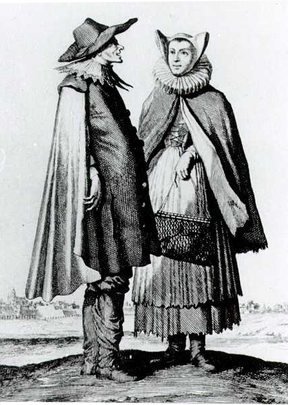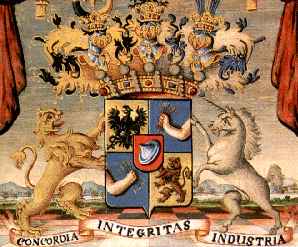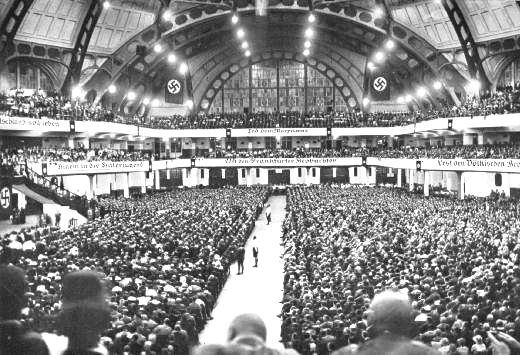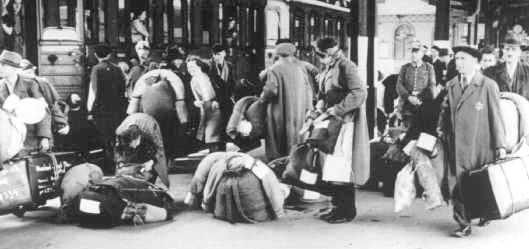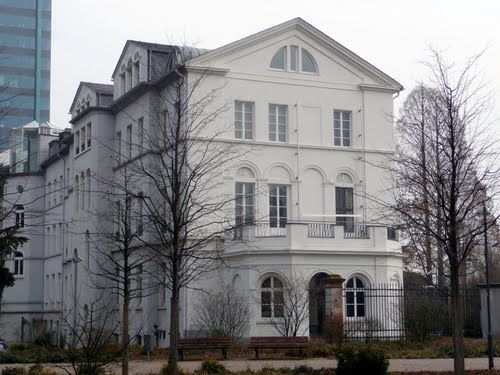Holocaust Education & Archive Research Team |
Occupation German Occupation of Europe Timeline
-
[The Occupied Nations]
Poland Austria Belgium Bulgaria Denmark France Germany Greece Hungary Italy Luxembourg The Netherlands Norway Romania Slovakia Soviet Union Sudetenland | ||||||||||||||||||||||||||||||||||||||||||||||||||||||||||||||||||||||||||||||||||||||||||||||||||||||||||||||||||||||||||||||||||||||||||||||||||||||||
Frankfurt am Main The City and the Holocaust
Founded in Charlemagne’s time, Frankfurt was for many years the site of the election and coronation of the German emperors, and in the fourteenth century it became an imperial free city, a status it retained until its annexation by Prussia in 1866.
Jews first settled in Frankfurt in 1074 and over the course of time its Jewish community became one of the most important in Europe. In the nineteenth century Frankfurt was a cultural centre of the Jewish Enlightenment (Haskalah), as well as of Neo- Orthodoxy.
It also played an important role in commerce, industry and banking – the Rothschild Bank had its centre in Frankfurt until the early twentieth Century. Two of the outstanding personalities based in Frankfurt in the twentieth Century were the philosophers, Franz Rosenzweig and Martin Buber.
In 1817 the city had a Jewish population of 3,300, which was ten percent of the total population, in 1930 this had risen to 30,000 and by June 1933, there were 26,158 Jews living in the city.
Frankfurt Am Main was one of the largest Jewish centres in Germany, second only to Berlin, it even had a Jewish mayor, Ludwig Landmann, when the Nazis came to power.
Following the Nazi rise to power on the 30 January 1933, the Jews of Frankfurt were subjected to physical assaults, as the Nazis did not wait for the official launching of the anti-Jewish boycott on the 1 April 1933.
Trade went down sharply in the Jewish stores and many went bankrupt and many Jewish owned enterprises were transferred to Nazi ownership. In the period from March to October 1933, 536 Jewish business enterprises in Frankfurt were closed.
The new Nazi mayor dismissed all Jews employed by the city even before the enactment of the national law to that effect, when the law was passed, the mayor had to re-instate Jewish employees who had seen active service in the Great War, since the new law specifically exempted them from dismissal.
Following the example set by the city government, all public institutions gradually dismissed the Jews on their books- the hospitals, law-courts, schools, university and institutes of culture and the arts.
When the Nuremburg Laws went into effect in 1935, Jews who had been front-line soldiers lost their exemption and were also let go, most privately owned commercial establishments also dismissed their Jewish employees.
As a result of the deterioration of economic conditions among the Jews, the two Jewish communities – the general and the “secessionist” Orthodox community- faced financial collapse. Their members, however, were willing to pay high community taxes and make substantial contributions in the form of cash or property, and thereby enabled the communities and welfare organisations to continue functioning.
In fact, in response to the growing needs, a large welfare network was established, in 1935, four thousand five hundred Jews were in need of help, this amounted to almost twenty percent of the Jewish population. In addition to financial assistance or help in kind – mainly clothing and food, a vocational training programme was set up, for the re-training of hundreds of youngsters of both sexes in productive occupations, trades and agriculture.
The Jews of Frankfurt – like Jews elsewhere in Germany – responded to their exclusion from society and cultural life by setting up their own cultural activities. In 1933 Martin Buber re-activated the Judisches Lehrhaus (Jewish Academy), which Franz Rosenzweig had established in the 1920’s, with a varied programme of lectures.
A Jewish symphony orchestra was formed, as were other musical groups and theatrical troupes, and the Jews had a rich schedule of performances and exhibitions from which to choose, ranging from music to photography.
A sports programme was also organised, with thousands of youngsters participating, these activities were confined to special sports complexes; in 1935 a special swimming pool was allocated as the only one to which Jews were admitted – the Jewish community paid an annual fee for its use.
In 1937 Jacob Hoffmann, the leader of the Mizrahi movement in Germany and the Orthodox rabbi serving the main community, was expelled to Hungary. Among the Polish Jews expelled from Germany on the 26 October 1938, 2,000 were from Frankfurt. On the 31 October they were allowed to return to the city, but were denied access to their homes, which in the interval had been sealed by the police.
The Jewish community provided accommodation for them in school buildings and private houses, and the Jewish welfare agencies took care of them until they were able to return to their own homes.
During the Kristallnacht pogroms on the 9 -10 November 1938, the big synagogues situated at Friedberger Anlage, Dominikanerplatz, Grosser Wollgraben, and Freiherr –vom- Stein-Strasse were burned down. Jewish Community buildings including the Jewish Museum and most of the small prayer houses were burned to the ground. Gangs of rioters roamed the streets, ransacking and destroying Jewish stores, and also causing loss of life.
In the following days, thousands of Jews were arrested in their homes, on the streets and in the railway stations. For several days they were detained in a large public hall, and were then taken to Buchenwald and Dachau concentration camps.
Nazi propaganda stressed the point that the family of German diplomat Ernst von Rath, whose murder was the pretext for the pogroms came from Frankfurt, and that by coincidence his assassin Herschel Grynszpan had been a student at the Frankfurt Yeshiva. The Yeshiva building was destroyed by the Nazis
In the wake of the pogrom and the ensuing riots and arrests, the Jews started fleeing from the city, in November 1938, 618 Jews left Frankfurt. In May 1939 13,751 Jews remained, half of the 1933 total; By the end of September 1941 the total number of the Jewish race had been reduced to 10,592.
The Frankfurt municipality purchased properties from the Jewish Community, belonging to both the main and the “secessionist” communities, which had merged in the wake of Kristallnacht, at a price much lower than their real value.
The large synagogues, except for one, were torn down, the old Jewish cemetery was levelled and from the other Jewish cemeteries all pieces of metal were removed, including the lettering on the tombstones, “for use in the war effort.”
The municipality had an official who was in charge of Jewish welfare, but in February 1940, a Gestapo officer in charge of “Jewish welfare” was appointed, representing both the Gestapo and the municipality; such a post existed only in Frankfurt. This officer Ernst Holland, handled all affairs relating to Jews in the city, and supervised all the Jewish property and the operations of the Jewish institutions still in existence.
His mandate was to reduce Jewish activities and save the costs involved, and to transfer Jewish property and financial assets to “Aryans.” This involved in part, evacuating Jews from their apartments and forcing them to move in with others or to find accommodation in the Jewish community buildings; in this way, the officer was able to transfer hundreds of Jewish apartments into German hands.
On the 4 March 1941 the Jews were ordered to perform forced labour and this too was under the Gestapo officer’s supervision, between Kristallnacht in November 1938 and 1943 715 Jews committed suicide in Frankfurt.
Jewish Transports from Frankfurt am Main to the East Date of Arrival at Destination 1941 -1945
After the war a new Jewish community was established in Frankfurt, and this has grown to the second largest in Germany, the one remaining large synagogue in the Westend quarter is again being used for religious services. However anti-Semitism still exists in the cirty and several Jewish cemeteries have been desecrated in recent decades.
One of Frankfurt’s most famous residents was Anne Frank; she was born in Frankfurt on the 12 June 1929. Otto and Edith marry in 1925 and settle in Frankfurt, they have two daughters, Margot born in 1926 and Anne, whose full name was Annelies Marie was born on the 12 June 1929.
In 1933 after Hitler seizes power and the anti-Jewish boycott, Otto Frank left Frankfurt for Amsterdam, he starts a branch of the Opekta company there, soon Edith, Margot and Anne join him in Holland.
The Frank family after hiding from the Nazis for two years were betrayed and captured by the Nazis.
The Jewish Museum in Frankfurt am Main
The Jewish Museum of the city of Frankfurt and its branch Museum Judengasse at Börneplatz are representing the historical development as well as the social and religious life of the Jewish communities in Frankfurt between the 12th and the 20th century. The changing relationship of Jews in Germany with their social environment is described here exemplarily on a local background. Temporary exhibitions in both branches complement the permanent exhibitions.
Jüdisches Museum Phone: +49 (0)69 212 35000
The History of the Second World War – published by Purnell London 1966 Encyclopaedia of Jewish Life Before and During the Holocaust, edited by Shumel Spector, published by New York University Press 2001 Die Judendeportationen aus dem Deutschen Reich 1941-1945 by Alfred Gottwaldt and Dianna Schulle published by Marix Verlag Gmbh- -Wiesbaden 2005 Jewish Museum Frankfurt am Main Wiener Library Chris Webb Archive Holocaust Historical Society NARA PRO
Copyright Chris Webb & Terry Nichols H.E.A.R.T 2012
|
